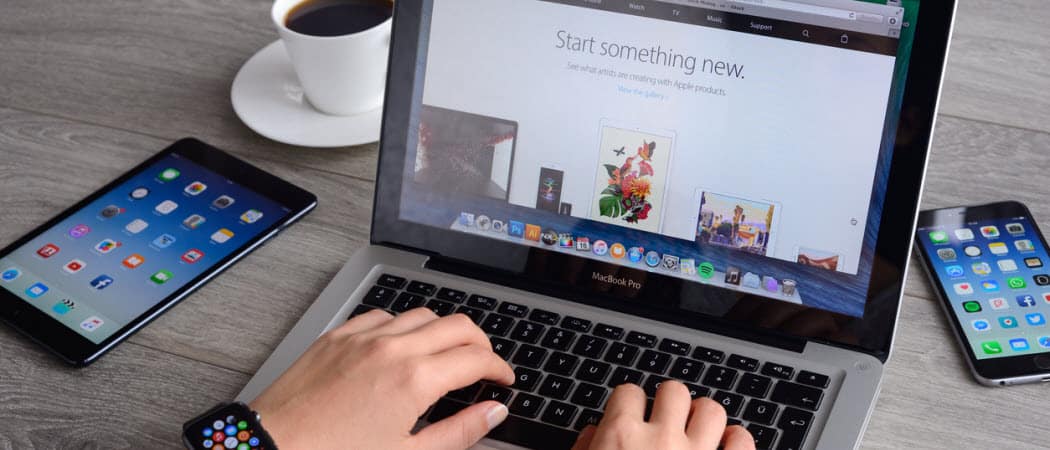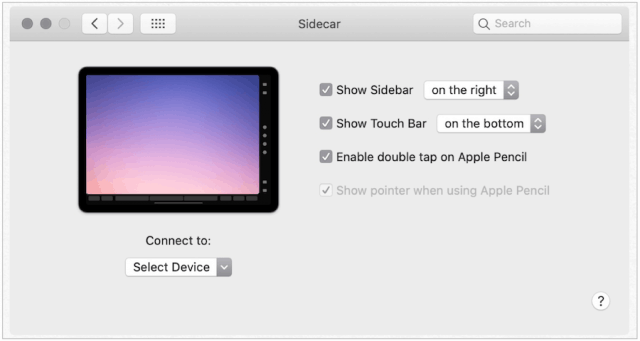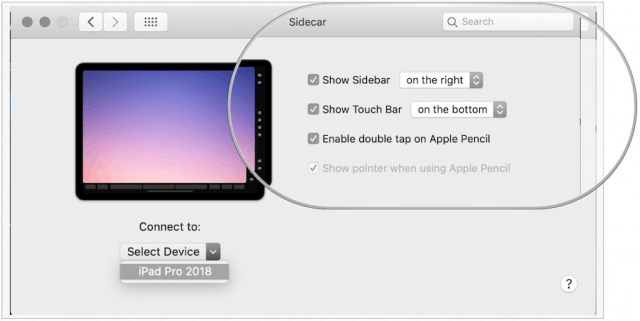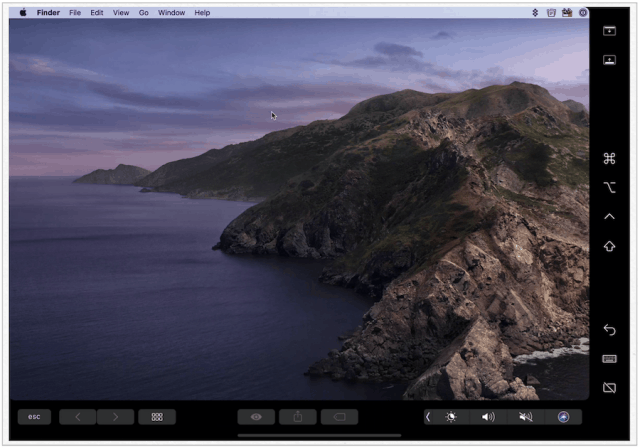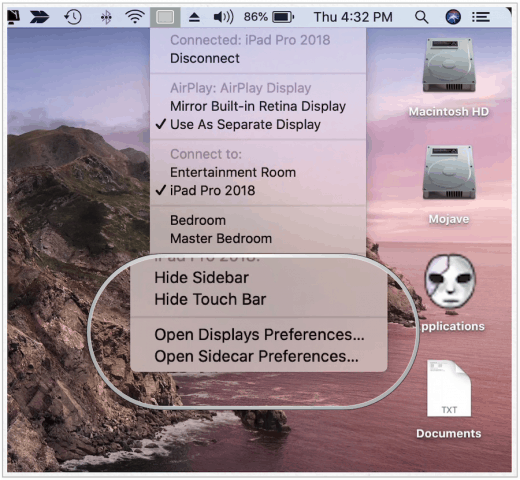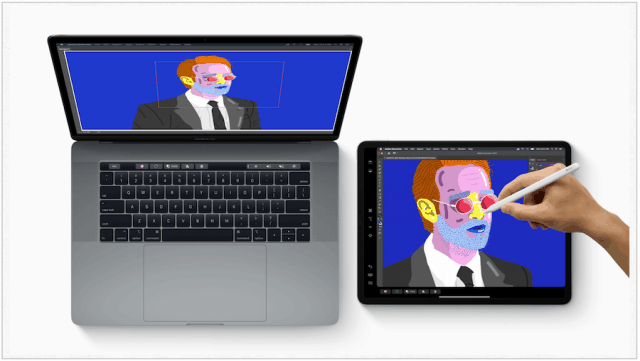Sidecar officially arrives when Apple releases macOS Catalina and iPadOS 13 later this year. Until then, the tool remains in beta.
What is Sidecar?
Products like Duet Display and Luna Display have long made it possible for mobile devices to act as a secondary screen for Mac. With Sidecar, Apple brings the functionality directly to macOS and iPad software for the first time.
Setting up Sidecar
To get started with Sidecar, your two devices must be connected with a USB-C cable or wirelessly over Wi-Fi. Both devices must also be logged into the same Apple ID, and Bluetooth must be active on both iPad and Mac. To activate a Sidecar session:
Your iPad is now connected to your Mac, and you should immediately see your Mac screen on your tablet.
Sidebar or Touch Bar?
When connecting your iPad and Mac, there are some settings you can adjust to suit your tastes. On the main Sidebar screen, you can decide whether to show your Mac’s Sidebar or TouchBar on your iPad and, if so, where to put them.
The Sidebar in Sidecar is where you’ll find your most-used controls and modifier keys in apps that support Sidecar. The Sidebar is also where you’ll discover markup tools and those that let you capture an entire webpage, document, or email. The Touch Bar is where you’ll find controls for apps that support Apple’s Touch Bar, which is physically found on late-generation MacBook Pro models. In this case, the digital TouchBar is available on your iPad, regardless of the type of Mac. In this example, the Sidebar is located on the right side of the display while the Touch Bar is on the bottom:
From the Sidecar page, you can also decide whether to enable a double tap on a second-generation Apple Pencil when you’re using a 2018 iPad Pro and whether to show a pointer when using an Apple Pencil.
How to Display
Once connecting your devices, you’ll need to decide whether to mirror the displays or extend the Mac’s screen onto your tablet. To make changes:
Next: In the following example, the Mac screen begins on the actual Mac and extends onto the iPad:
As An Input Device
Unlike other companies, Apple has never released a computer with touch controls. Sidecar will change this — at least to a degree. The star of this process is Apple Pencil. With Mac apps that support Sidecar, you’ll be able to use your input device to write and draw via your iPad. Not surprisingly, the apps that are expected to support this technology fall into the creative categories of illustration, photography, and 3D. Titles include Adobe Illustrator, Affinity Photo, Maya, and a few others. Many of Apple’s native Mac apps will also support work with Apple Pencil. This sounds exciting, and as a quasi-creative, I can’t wait to incorporate this kind of interaction into my work process. For now, however, we’re primarily left with the Sidecar demo Apple presented earlier in the summer. Though the process works to a limited degree in the current macOS Catalina beta, it’s not a finished product. No doubt, we’ll hear more about this once macOS Catalina is released to the public. Regardless, it will be interesting to see where this goes from here in the months and years to come.
Who can use Sidecar?
According to the Apple website, the following Macs will support macOS Catalina:
MacBook, 2015 and lateriMac, 2012 and laterMacBook Air, 2012 and lateriMac Pro, 2017 and laterMacBook Pro, 2012 and laterMac Pro, 2013 and laterMac mini, 2012 and later
Conversely, the following iPads will support iPadOS 13:
12.9-inch iPad Pro11-inch iPad Pro10.5-inch iPad Pro9.7-inch iPad ProiPad (5th and 6th generation)iPad mini (4th and 5th generation)iPad Air (3rd generation)iPad Air 2
If you own an older Mac, it’s still possible you can at least try to use Sidecar, at least according to one Reddit poster.
What About Similar Tools?
Apple has a history of incorporating features found on third-party apps into new native apps. Eventually, the official app often overtakes the original one or eliminates it. Known by many as “sherlocking,” the practice is one of the risks of working as a developer for a high-profile, popular third-party app. For now, the makers of Duet Display and Luna Display are taking a wait-and-see approach to the impending debut of Sidecar. In discussions with TechCrunch soon after the Apple announcement, the heads of both companies promised to move forward by diversifying what they offer. Duet Founder and CEO Rahul Dewan explained, “The plan has been for the past about two years to become more of a company for remote tools, for remote workers and people that are traveling a lot. That’s the way we’ve been positioning, first by adding on these features, like remote desktop. We actually have a couple of other big product launches that are not connected to space this summer. We should be fairly diverse.” Meanwhile, Matt Ronge, CEO of Luna maker Astro HQ, said, “Moving forward, we’re going to double down on serving the creative pro community. While Apple builds features to satisfy the masses, we’ve always committed to building products with rich features and deep customization for professional creative workflows. For example, Astropad Studio comes with features like Magic Gestures, per-app shortcuts, and custom pressure curves.”
Bottom Line
Where Sidecar goes from here is anyone’s guess. In the interim, you should consider the already out tools, then test Apple’s offering when it arrives. Stay tuned! Apple’s expected to release new versions of macOS and iPadOS in September.
![]()
